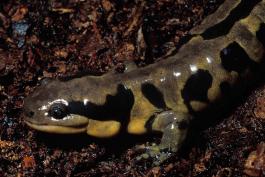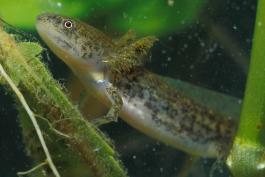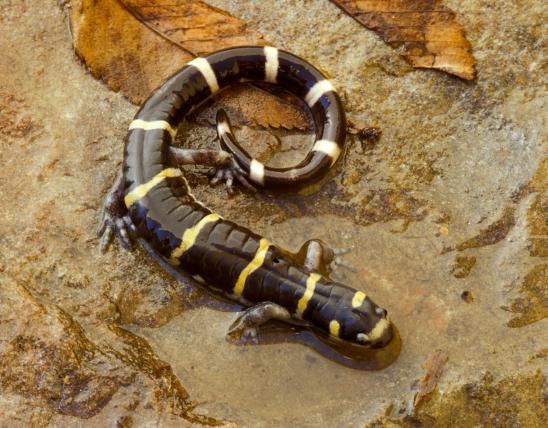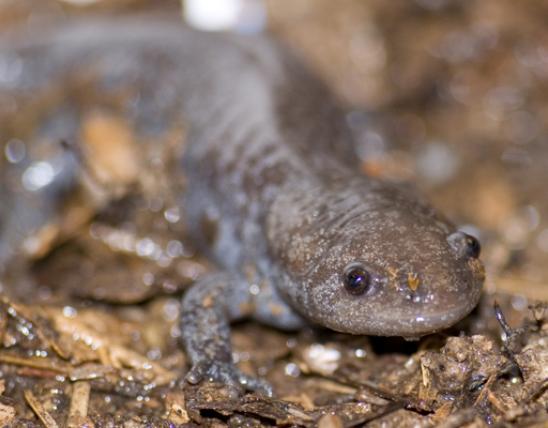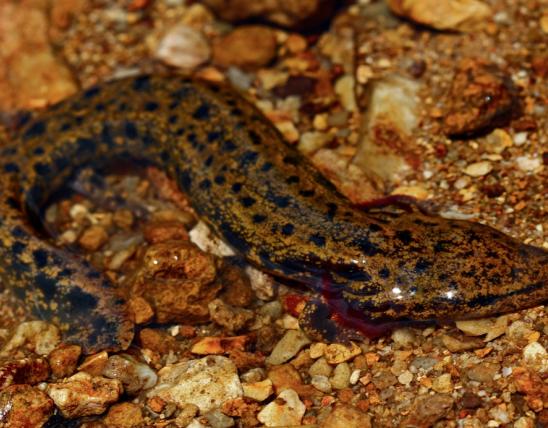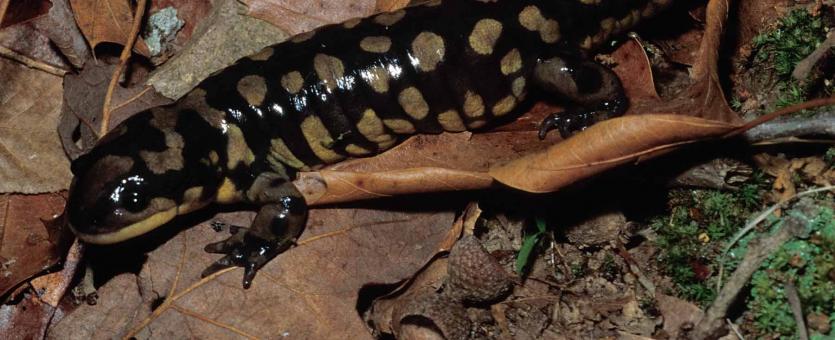
The eastern tiger salamander is a dark, medium to large salamander with yellow or olive blotches over the head, body, and tail.
The ground color is black or dark brown. The large spots or blotches vary greatly in size and shape; their color ranges from bright yellow to dull olive brown. The belly is dark gray or black with yellow to olive-yellow mottling. There are 11–14 riblike costal grooves.
Similar species: This is one of six Missouri species of mole salamanders (family Ambystomatidae); all six are in genus Ambystoma. This is the only one with irregularly shaped yellow or yellowish blotches or spots.
Adult length: 7–8¼ inches, but occasionally to 13 inches.

Presumed statewide. There are few records in the Osage Plains of southwest Missouri and the Mississippi Alluvial Basin of southeast Missouri. It is most common in the northern half of the state, especially in northwestern Missouri. Small, isolated populations occur in the Ozark Highlands in former savanna and prairie habitat.
Habitat and Conservation
Eastern tiger salamanders live in a wide variety of habitats, including woodlands, savannas, swamps, prairies, and old fields near farm ponds. Sometimes they occur in and around croplands. Most Missourians see them in grassland habitats or in wells, basements, and root cellars. These salamanders spend most of their time in burrows or under logs and are active only at night.
Eastern tiger salamanders become migratory during autumn rains, moving to ponds, where they will breed in winter or early spring. Missourians have noticed these salamanders near homes or crossing roads in November and December.
Unlike many of the salamanders in the genus, eastern tiger salamanders actively dig their own burrows in the soil, although they can use crevices and burrows made by other small animals.
Eastern tiger salamanders need fishless water holes, ponds, and swamps to survive, and you can help them by developing and maintaining these features on your property.
Tiger salamanders belong to the mole salamander family, named because they spend most of their time underground, often in burrows made by small mammals or under logs and rocks. Your best chance of seeing a tiger salamander is at night in autumn, after a heavy rain.
Food
Prey includes any animal small enough for them to swallow, ranging from small invertebrates to young mice, small frogs, and snakes, and even other salamanders. Common foods include earthworms, insects, spiders, slugs, and snails.
Status
A species of conservation concern in Missouri. Populations are declining.
Loss and fragmentation of native prairies and savanna habitat, loss of wetlands, patchy distribution, and small population size threaten this species in Missouri. Constructing and maintaining shallow, fishless wetlands for breeding is vital to the long-term persistence of this species in Missouri.
Life Cycle
During autumn rains individuals migrate to fishless ponds where they will later breed. Courtship and egg-laying occur in the water between February and April, peaking in March. Each female may lay up to 1,000 eggs deposited in small clumps of 23–110. Eggs hatch within several weeks, or up to 40–50 days if water temperatures are cold. The aquatic, gilled larvae develop in summer and transform to land-dwelling subadults in late summer, June through August. The lifespan can be 10 years or more; in captivity, the lifespan has exceeded 20 years.
Human Connections
Habitat conservation is important for keeping this species present in Missouri.
These nifty amphibians, though seldom seen, reward their viewers with their striking yellow or olive and black patterns. They are part of the amazing wild heritage of Missouri.
The larvae of this species are sometime erroneously called waterdogs. That term, however, is a common name for the mudpuppy.
At one time, larval tiger salamanders could be sold and used for fish bait in Missouri, but this market was eliminated because many bait animals carry infectious diseases that can harm native amphibians.
Ecosystem Connections
Numerous animals prey on tiger salamanders and their eggs and larval forms, including predaceous diving beetles, fish, herons, and loggerhead shrikes. The salamanders themselves prey on a host of invertebrates ranging from snails and slugs to insects and spiders.










